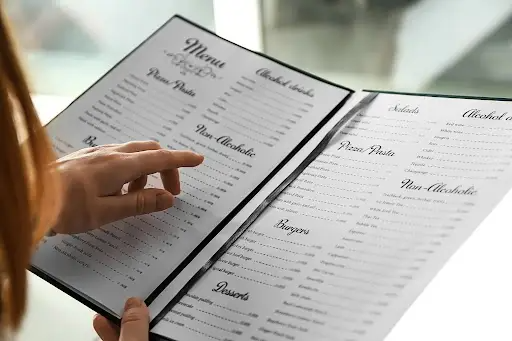Before delving into the impact of menu presentation on customers' choices, it's essential to appreciate the quintessential place the menu holds in a restaurant's operations. Think about it, what's the first thing a customer asks for after finding a comfortable seat? The menu, of course! It's not simply a food listing but a crucial 'silent salesperson' that, when leveraged right, can significantly boost your revenue and brand image.

Importance Of Menu Presentation
The importance of menu presentation in the restaurant industry cannot be overstated. A well-designed menu serves as the primary communication tool between a restaurant and its customers. It goes beyond merely listing dishes and prices; it is a reflection of the restaurant's identity, style, and culinary prowess. Menu presentation sets the stage for the dining experience, influencing customers' perceptions, expectations, and choices.
First impressions matter, and a visually appealing menu can create a lasting one. A thoughtfully crafted layout with appealing fonts, colors, and images can entice diners and make them feel more comfortable and confident in their choices. Moreover, a well-organized menu helps customers navigate their options effortlessly, enhancing the overall dining experience.
Menu design also plays a pivotal role in conveying the restaurant's personality and brand. Whether it's a sophisticated fine dining establishment or a trendy casual eatery, the menu's visual elements should align with the restaurant's ambiance and target audience. The choice of words, descriptions, and images should tell a story about the cuisine, creating anticipation and excitement.
Furthermore, menu presentation can influence sales and profitability. Strategic placement of high-margin items, enticing descriptions, and well-chosen visuals can lead diners to order certain dishes or drinks, boosting revenue. In contrast, a poorly designed menu can confuse customers, leading to indecision or dissatisfaction.
In essence, menu presentation is a powerful tool that shapes diners' perceptions, enhances their experience, and impacts a restaurant's bottom line. It's not just a list of dishes; it's a work of art that can make or break a restaurant's success.
Menu's Impact On Operations
A restaurant's operations revolve around its menu. From food and beverage purchases, inventory control, kitchen and server staffing, to decisions about the equipment needed, everything derives from the menu. More so, the menu also affects an operation's overall image and profitability.
Crucial Element In Branding
From the logo to the choice of font and color, the menu is central to shaping an operation's image. It forms an integral part of the dining ambiance, carrying the brand voice, ethos, and personality.
Psychological Influence On Spending
The menu can be a cleverly disguised tool for boosting your restaurant's profits by influencing customers' perception of value. Strategic placement of high-profit items, use of attractive descriptions, and price anchoring navigation techniques can subtly nudge customers into choosing items that boost your bottom line.
Keys To Effective Menu Planning
As it is now clear that the menu's hold expands beyond menu selections, let's delve into the importance of careful menu planning.
Ensuring Variety And Balance
An effectively planned menu provides a variety of dishes catering to different customer preferences and dietary requirements. It showcases a balance between high and low-cost ingredients, ensuring customer satisfaction while maintaining profitability.
Optimizing Kitchen Operations Efficiency
Menu planning considers the operational side of the kitchen, the equipment available, staff skills, and workload distribution. This understanding aids in developing a menu balance that ensures operational efficiency without compromising food quality or customer service.
Unlocking The Benefits Of Menu Analysis
Menu engineering and analysis form a crucial part of effective menu planning, featuring several benefits that can bring your restaurant operation to the next level.
Identifying Stars And Puzzles On Your Menu
Menu analysis helps distinguish high performers (Stars) and underperformers (Puzzles), guiding you in making strategic changes. It facilitates promoting Stars, re-engineering or eliminating puzzles and ultimately streamlining your menu for improved customer satisfaction and profits.
The Psychology Of Menu Design
Now comes the most intriguing part: How do restaurants design menus to direct customers to spend more? Several design aspects, such as colors, fonts, and structure, influence customer choices subtly.

Colors And Their Impact
The colors used in a menu design wield a subtle yet powerful influence over a customer's dining experience. Each hue carries its own psychological and emotional connotations that can significantly impact a patron's choices and overall satisfaction. Warm, appetizing colors like deep reds and rich browns often stimulate the appetite and create a sense of comfort, making them ideal for highlighting signature dishes or hearty comfort foods. In contrast, cool shades such as blues and greens evoke a sense of freshness and tranquility, which can be used to promote healthier options or convey a relaxed dining atmosphere.
The strategic use of color can guide customers' attention and steer them toward particular items on the menu. Vibrant, eye-catching colors can draw the eye to featured specials or high-margin dishes, encouraging patrons to explore these offerings. Additionally, color can indicate dietary information, such as green for vegetarian options or red for spicy dishes, aiding those with specific dietary preferences or restrictions.
Furthermore, the overall color palette and design aesthetics can set the tone for the entire dining experience. Earthy, rustic colors evoke a cozy, family-friendly atmosphere, while sleek, modern hues convey sophistication and elegance. Ultimately, the colors chosen for a menu design play a pivotal role in shaping customers' perceptions, emotions, and choices, making them a vital aspect of restaurant marketing and branding.
Font Choice And Size
The font style and sizes in a menu design play a pivotal role in shaping a customer's dining experience. These seemingly subtle design choices hold immense power in influencing diners' choices, perceptions, and overall satisfaction. The selection of font style can convey a restaurant's personality and theme. For instance, a classic serif font might evoke a sense of elegance and tradition, while a playful script font can exude a whimsical charm.
Font size, on the other hand, directly impacts readability and comprehension. Too small, and customers may struggle to decipher the menu, leading to frustration. Too large, and it can appear overwhelming or lacking refinement. Proper sizing ensures that customers can comfortably peruse the offerings, enhancing their sense of control and understanding. Additionally, font size can guide attention; larger headings draw eyes to special dishes or categories, encouraging exploration.
The font style and size can also communicate hierarchy and pricing. Bold fonts or distinct styles may highlight premium items or chef's recommendations, prompting customers to indulge. Conversely, subtle fonts for prices can mitigate sticker shock and encourage patrons to focus on the culinary experience rather than cost.
In sum, font style and size are the unsung heroes of menu design, silently guiding customers' choices, setting the tone, and influencing their perception of a dining establishment, ultimately shaping the overall dining experience. A well-executed menu design becomes an integral part of the restaurant's identity, enhancing customer engagement and satisfaction.
Strategic Menu Structure
The layout and structure of a menu design wield significant influence over a customer's dining experience. A well-crafted menu is a carefully curated piece of art that can sway choices, enhance satisfaction, and even boost revenue for a restaurant. The organization of dishes, categories, and pricing all play pivotal roles.
Firstly, the arrangement of items can guide a customer's decision-making process. Placing high-profit or signature dishes strategically can draw attention and drive sales. Additionally, grouping items logically into categories, such as appetizers, entrees, and desserts, aids navigation and fosters a sense of order.
Moreover, the visual design, typography, and use of images all contribute to a customer's perception of the restaurant and its offerings. Clean, readable fonts and high-quality imagery can evoke a sense of sophistication, while a cluttered design may overwhelm and deter diners.
Pricing placement and formatting also carry weight. Cleverly positioning prices without dollar signs (e.g., "14" instead of "$14.00") can create a perception of value, and using a consistent format (e.g., right-aligning prices) makes it easier for customers to scan for cost.
In sum, a well-structured menu is a powerful tool that guides customers' choices, enhances their dining experience, and influences their perception of the restaurant. A thoughtful approach to menu design can leave a lasting impression, ensuring diners leave not only satisfied but also eager to return.

Final Thoughts On Effective Menu Creation
When it comes to influencing customers' decisions in a dining establishment, the power of effective menu presentation should never be underestimated. A well-designed menu serves not only as a directory of the dishes available but also as a sublime tool that, when used skillfully, can steer customers toward preferred choices, thereby boosting profitability.
Remember, a strategic alignment of design elements can create an enticing visual feast, drawing your customers into a delightful culinary journey even before they taste the first morsel. With each well-executed detail, you're not just presenting a menu but curating an exceptional dining experience that leaves a lasting impression.






